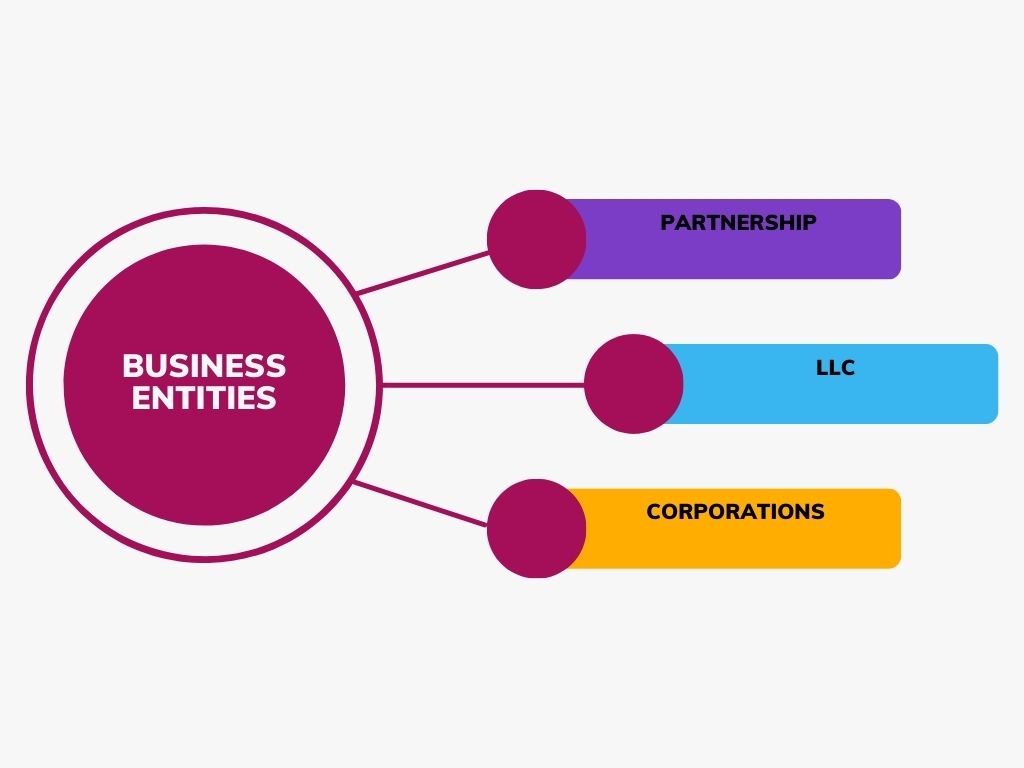Business Entities – Which is the right one for you?
Making the right choice for your company’s legal and financial structure is crucial because it will have a big impact on both. There are various business entities, and each has particular benefits and drawbacks. This article will examine the most typical company entities, as well as their benefits and drawbacks.
1. Sole Proprietor:
The most typical type of ownership for many new enterprises is the sole proprietorship. Most people who want to keep absolute and entire control over their business utilise this as their legal entity. The creation of this type of company entity is also the simplest. It’s a business that is owned and operated by a single person who is also personally liable for all of the company’s obligations and liabilities. If the company is sued or files for bankruptcy, creditors may claim the owners’ assets. On the other hand, there is no double taxation of profits, and the owner still has total authority over the entire business.
Pros:
Easy to set up
Easy to control
Profits are taxed as personal income
Cons:
The owner personally carries all liability for the business
Limited ability to raise capital
The company usually dies with the owner
2. Partnership:
Partnership is a business entity that involves additional owners who share the earnings and losses, mirroring the structure of a sole proprietorship. This category forms two types of partnerships below.
General Partnership: In a general partnership, each partner is jointly and severally liable for all financial obligations the company incurs. This indicates that the entire partnership’s financial liabilities are each partner’s personal responsibility. This arrangement implies that each partner is responsible for the full debt regardless of their personal investment or engagement in the firm if the company encounters financial difficulties or legal liabilities. The general partnership structure emphasizes shared responsibility and equal distribution of liabilities among the partners.
Limited Partnership: A limited partnership, as opposed to a general partnership, enables different levels of responsibility among the partners based on their individual investments in the company. General partners and restricted partners are the two sorts of partners in this kind of partnership. While limited partners have limited liability, which means their obligation is limited to the amount of their investment in the company, general partners have joint and several liability, as in a general partnership. Limited partners often play a supporting function in the company and are not involved in management or day-to-day operations. The distribution of ownership-related risks and profits among the partners is flexible because to this arrangement.
Pros:
Cost-effective and easy to set up
shared accountability for managing and managing the funds
split losses and gains with partners
Cons:
Partners are personally liable for the debts and obligations of the firm.
Conflicts amongst the persons involved could eventually cause the firm to fail.
limited capacity for raising money
3. LLC: Limited Liability Company
Small enterprises typically form LLCs when they want to preserve their employees’ personal assets without having to deal with the formalities of a conventional corporate structure. A partnership and a S Corporation are combined to form an LLC. Owners of LLCs benefit from both, giving them one of the most well-liked business structures. Members of an LLC are the owners who are not personally liable for the business but who nevertheless receive pass-through tax benefits.
Pros:
Personal defence against business debt and liabilities
Adaptable organisational framework
passing taxes through
Cons:
costlier to establish than a sole proprietorship
One must observe complicated rules and protocols.
limited capacity for raising money
4. Companies:
Companies are distinct legal entities that are owned by shareholders. Stocks and bonds can be used by corporations to raise capital; stockholders are not personally liable for the debt of the company. Companies wishing to raise financing frequently choose this entity.
Pros:
Shareholders are only partially liable for the debt and obligations of the corporation.
Ability to raise significant sums of money
continuation of the business notwithstanding ownership changes and stock transfers to new shareholders
Cons:
The costliest thing to make
State laws varies
When a corporation faces taxation on its profits as well as the income of its owners, it undergoes double taxation.
5. Corporations that are nonprofit:
Typically, non-profit corporations are used for charitable, educational, or other public objectives. Additionally, This is the organisation of choice for groups who care more about having an impact on the public or the community than on turning a profit. Donations to nonprofit organizations are tax deductible and they are excluded from both federal and state income taxes.
Pros:
the absence of taxes
receiving tax-deductible contributions
Cons:
designed with a specific objective
Obtaining the unique non-profit status requires a lot of paperwork.
6. Professional Corporation (PC):
Licensed professionals, such as doctors, lawyers, and accountants, use professional companies as a type of legal entity created especially to carry out their line of work. Additionally, individual professionals are given some liability protection; however, they are nonetheless personally responsible for their own professional negligence.
Moreover, It’s vital to remember that each company entity may have different criteria and distinctive characteristics depending on the location and local legislation. Legal and financial experts recommend seeking their advice when determining which company entity is best for your unique situation.
7. Corporations:
Shareholders own corporations as separate entities. A corporation can raise capital by issuing stocks and bonds; shareholders don’t carry personal liability for the company debt. This is often the entity of choice for companies looking to raise capital.
Pros:
Shareholders have limited liability for company debt and obligation
Ability to raise large amounts of capital
Cons:
The most expensive entity to create
Companies must follow large amounts of state rules and regulations.
8. Non-profit Corporations:
Typically, individuals or organizations use NGO (Non-Govt.) or a non-profit organization for charitable, educational, or other objectives that benefit the public. For organizations that care more about having an impact on the community/society or the public than making a profit, this is the preferred entity. Furthermore, Donations to non-profit organizations are deductible for federal and state income taxes.
Pros:
Tax-exempt status
Ability to receive tax-deductible donations
Cons:
Created for a specific purpose
Requires a lot of documentation to receive the special status of a NGO
Our Virtual Offices are a B2B provider of virtual administrative services that can help you run your business more efficiently. If you need a prestigious corporate address in a new market due to corporate growth, Wherever business opportunity strikes, Lakeview campus Virtual Office is there!Regardless of which entity you choose, in addition, We can work with you to expand into new markets, grow your customer reach, and take care of the daily minutia that goes into running a successful business.





